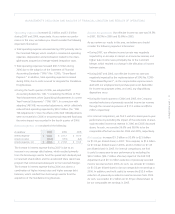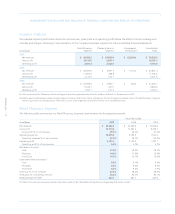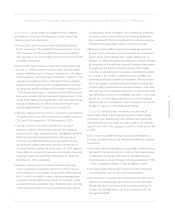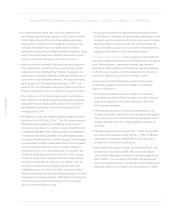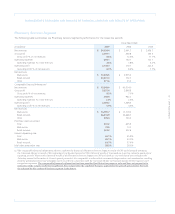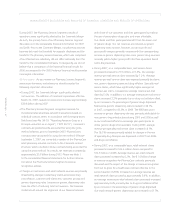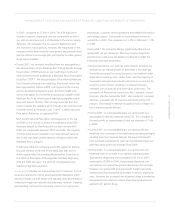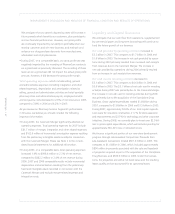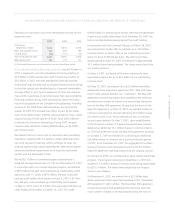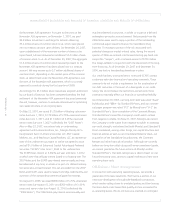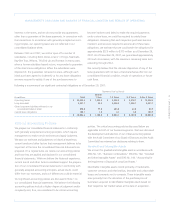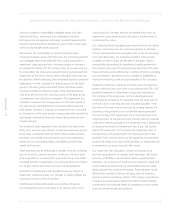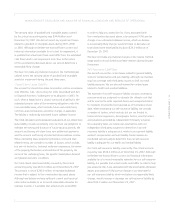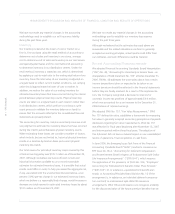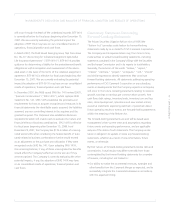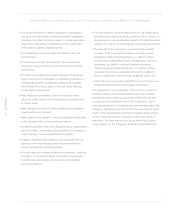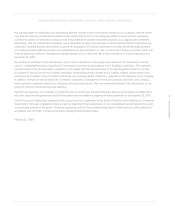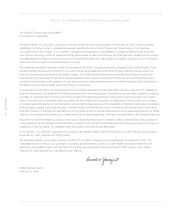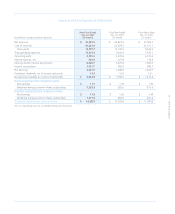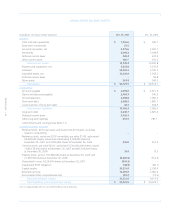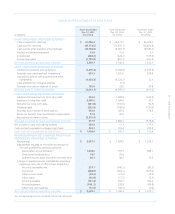CVS 2007 Annual Report Download - page 35
Download and view the complete annual report
Please find page 35 of the 2007 CVS annual report below. You can navigate through the pages in the report by either clicking on the pages listed below, or by using the keyword search tool below to find specific information within the annual report.
31 I 2007 Annual Report
become insolvent and failed to make the required payments
under a store lease, we could be required to satisfy these
obligations. Assuming that each respective purchaser became
insolvent, and we were required to assume all of these lease
obligations, we estimate that we could settle the obligations for
approximately $325 million to $375 million as of December 29,
2007. As of December 29, 2007, we guaranteed approximately
220 such store leases, with the maximum remaining lease term
extending through 2022.
We currently believe that the ultimate disposition of any of the
lease guarantees will not have a material adverse effect on our
consolidated financial condition, results of operations or future
cash flows.
interests in the stores, and we do not provide any guarantees,
other than a guarantee of the lease payments, in connection with
the transactions. In accordance with generally accepted account-
ing principles, our operating leases are not reflected in our
consolidated balance sheet.
Between 1991 and 1997, we sold or spun off a number of
subsidiaries, including Bob’s Stores, Linens ’n Things, Marshalls,
Kay-Bee Toys, Wilsons, This End Up and Footstar. In many cases,
when a former subsidiary leased a store, we provided a guarantee
of the store’s lease obligations. When the subsidiaries were
disposed of, the guarantees remained in place, although each
initial purchaser agreed to indemnify us for any lease obligations
we were required to satisfy. If any of the purchasers were to
Following is a summary of our significant contractual obligations as of December 29, 2007:
Payments Due by Period
Within
In millions Total 1 Year 1–3 Years 3–5 Years After 5 Years
Operating leases $ 22,090.6 $ 1,584.5 $ 3,202.8 $ 2,918.7 $ 14,384.6
Long-term debt 8,251.7 45.5 2,402.4 1,802.7 4,001.1
Other long-term liabilities reflected in our
consolidated balance sheet 398.8 77.0 235.4 22.5 63.9
Capital lease obligations 145.1 1.6 4.1 5.5 133.9
$ 30,886.2 $ 1,708.6 $ 5,844.7 $ 4,749.4 $ 18,583.5
Critical Accounting Policies
We prepare our consolidated financial statements in conformity
with generally accepted accounting principles, which require
management to make certain estimates and apply judgment.
We base our estimates and judgments on historical experience,
current trends and other factors that management believes to be
important at the time the consolidated financial statements are
prepared. On a regular basis, we review our accounting policies
and how they are applied and disclosed in our consolidated
financial statements. While we believe the historical experience,
current trends and other factors considered support the prepara-
tion of our consolidated financial statements in conformity with
generally accepted accounting principles, actual results could
differ from our estimates, and such differences could be material.
Our significant accounting policies are discussed in Note 1 to
our consolidated financial statements. We believe the following
accounting policies include a higher degree of judgment and/or
complexity and, thus, are considered to be critical accounting
policies. The critical accounting policies discussed below are
applicable to both of our business segments. We have discussed
the development and selection of our critical accounting policies
with the Audit Committee of our Board of Directors and the Audit
Committee has reviewed our disclosures relating to them.
Goodwill and Intangible Assets
We account for goodwill and intangible assets in accordance with
SFAS No. 141, “Business Combinations,” SFAS No. 142, “Goodwill
and Other Intangible Assets” and SFAS No. 144, “Accounting for
the Impairment or Disposal of Long-Lived Assets.”
Identifiable intangible assets consist primarily of trademarks,
customer contracts and relationships, favorable and unfavorable
leases and covenants not to compete. These intangible assets
arise primarily from the allocation of the purchase price of
businesses acquired to identifiable intangible assets based on
their respective fair market values at the date of acquisition.


